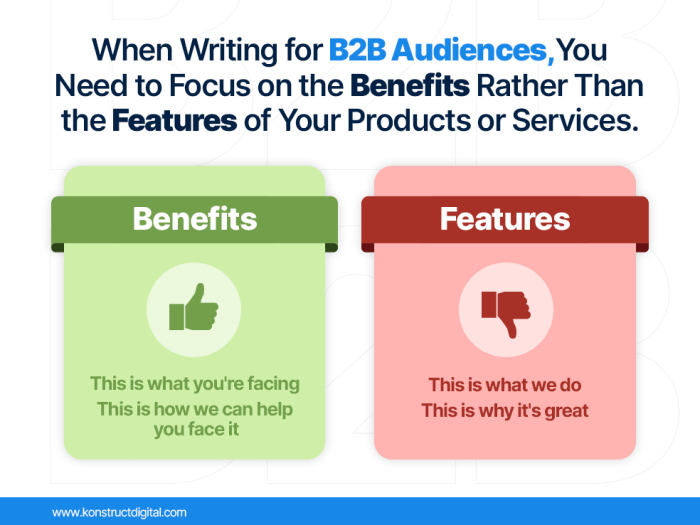Writing for B2B Audiences dives into the realm of tailored communication for businesses, serving up tips and strategies with an American high school hip vibe that’s sure to keep readers hooked.
Get ready to explore the ins and outs of engaging B2B content creation in a way that’s informative and entertaining.
Introduction to Writing for B2B Audiences

B2B audiences, or business-to-business audiences, refer to companies or organizations that purchase goods or services from other businesses for their operations. These audiences are characterized by their focus on efficiency, cost-effectiveness, and the need for solutions that can help them achieve their business goals.
Effective communication with B2B audiences is crucial for building strong relationships and driving business growth. Tailored communication that addresses the specific needs, challenges, and goals of these audiences can help businesses establish trust, demonstrate expertise, and ultimately, win new customers.
Importance of Tailored Communication for B2B Audiences
When creating content for B2B audiences, it’s essential to tailor your communication to address their unique pain points and offer solutions that align with their business objectives. By understanding the specific needs and challenges of your B2B audience, you can create content that resonates with them and positions your business as a valuable partner.
Examples of Successful B2B Content Strategies
- Case Studies: Sharing real-life examples of how your products or services have helped other businesses can demonstrate your value and credibility to B2B audiences.
- Whitepapers: In-depth research reports or whitepapers that provide valuable insights and solutions to common industry challenges can establish your business as a thought leader in the space.
- Webinars: Hosting webinars on relevant topics can engage B2B audiences and provide them with valuable information that can help them address their business needs.
Understanding B2B Audience Needs: Writing For B2B Audiences
When it comes to writing for B2B audiences, understanding their needs is crucial for creating effective content that resonates with them. Researching B2B audience needs involves delving deep into the industry, analyzing trends, and identifying pain points and challenges they face on a daily basis.
Researching B2B Audience Needs, Writing for B2B Audiences
To research B2B audience needs, start by conducting market research to gain insights into the industry landscape. This can involve analyzing industry reports, attending conferences, and networking with professionals in the field. Additionally, use tools like surveys, interviews, and analytics to gather data on customer behavior and preferences.
- Utilize social media monitoring tools to track conversations and sentiments within the industry.
- Engage with industry forums and online communities to understand common challenges faced by B2B audiences.
- Analyze competitor content to identify gaps that your content can fill to meet audience needs.
Identifying Pain Points and Challenges
Identifying pain points and challenges faced by B2B audiences is essential for addressing their needs effectively. This involves empathizing with their struggles and understanding the obstacles they encounter in their professional roles.
By putting yourself in the shoes of your B2B audience, you can gain valuable insights into their pain points and challenges, allowing you to tailor your content to provide solutions and valuable resources.
- Conduct surveys and interviews to directly ask B2B professionals about their biggest challenges and pain points.
- Analyze customer support inquiries and feedback to pinpoint common issues faced by B2B customers.
- Monitor industry trends and news to stay informed about emerging challenges that B2B audiences are grappling with.
Informing Content Creation
Understanding B2B audience needs plays a pivotal role in informing content creation strategies. By aligning your content with the needs and challenges of B2B audiences, you can create valuable, relevant, and engaging material that resonates with them.
- Develop targeted content that addresses specific pain points and challenges faced by B2B audiences.
- Create educational resources, such as whitepapers and case studies, that provide solutions to common issues within the industry.
- Personalize your content to cater to different segments of the B2B audience, ensuring that each piece speaks directly to their needs and interests.
Crafting Engaging B2B Content
Creating content that captivates B2B audiences requires a strategic approach that combines relevance, professionalism, and engagement. Here are some tips to help you craft compelling content for your B2B audience.
Storytelling in B2B Content Marketing
Storytelling plays a crucial role in B2B content marketing by humanizing your brand and creating a connection with your audience. Instead of bombarding them with technical jargon, weave a narrative that resonates with their challenges and aspirations. Use real-life examples, case studies, and testimonials to illustrate how your product or service can solve their problems.
Maintaining Professionalism in B2B Writing
While storytelling adds a personal touch to your content, it’s essential to maintain a level of professionalism when writing for B2B audiences. Avoid using slang, emojis, or informal language that may undermine your credibility. Stick to a formal tone, backed by data, research, and industry insights. Balance engaging storytelling with factual information to build trust and authority in your content.
Tailoring Tone and Style for B2B Communication

When it comes to B2B writing, it’s essential to tailor your tone and style to suit the professional audience you are targeting. Unlike B2C communication, B2B writing requires a more formal and professional approach to establish credibility and trust with your business partners. However, it’s also important to strike a balance between formal and conversational language to keep your content engaging and accessible.
Appropriate Tone and Style for B2B Writing
In B2B communication, the tone should be professional, authoritative, and respectful. Avoid using slang, jargon, or overly casual language that may come across as unprofessional. Keep your content clear, concise, and focused on providing valuable insights and information to your B2B audience.
Adapting Tone Based on the Target B2B Audience
When adapting your tone for different B2B audiences, consider factors such as industry, company size, and job roles. For example, if you are targeting a tech-savvy startup, you may use a more casual tone to resonate with their culture. On the other hand, if your audience consists of executives from large corporations, a more formal tone would be appropriate to match their level of professionalism.
Balancing Formal and Conversational Language in B2B Content
To strike a balance between formal and conversational language in B2B content, consider the context of your communication. Use formal language in reports, whitepapers, and official documents, while incorporating a conversational tone in blog posts, social media updates, and email newsletters. This helps maintain professionalism while keeping your content engaging and relatable to your B2B audience.